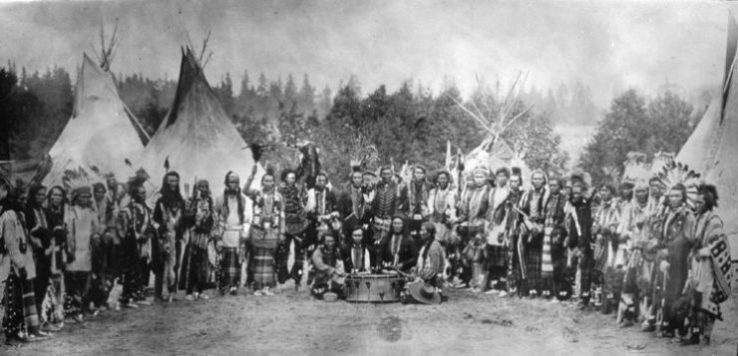At Fort Hall on the feast of the Assumption they met the advance-guard of the Flatheads, who had traveled over three hundred miles to come and meet the Black Robes. Among them was Young Ignatius, Father De Smet’s guide of the previous year. Ignatius had been running for four days without food or drink in order to be the first to salute the missionaries.
Simon, the oldest member of the tribe, was also in the advance-guard. Although so worn with age that even when seated he leaned upon a cane for support, the ardor of his youth revived upon hearing of the approach of the Black Robes. “My children,” said he, as he mounted his horse, “I am one of you; if I succumb on the way our Fathers will know in what cause I die.” During the journey he was often heard to say: “Courage, my children, remember we go to meet the Black Robes!” Then lashing their steeds and following their intrepid leader, the cavalcade covered fifty miles a day.
Father De Smet’s heart rejoiced when he found that the year’s interval had in no way diminished the fervor of the Flatheads. The greater number, even old men and little children, knew by heart the prayers he had taught them. Twice on weekdays, and three times on Sundays, during his absence had the tribe assembled to say prayers in common. The box containing vestments, and the altar service left in their charge the preceding year, were carried on high like the Ark of the Covenant each time the camp moved.
Many of those baptized died saintly deaths. A girl twelve years of age exclaimed at the moment of death: “How beautiful! How beautiful! I see the heavens opening and the Mother of God is calling me to come!” Then turning to those about her she said: “Heed what the Black Robes tell you, for they speak the truth; they will come and in this place erect a house of prayer.”
Enemies of Catholicism vainly endeavored to sow dissension and distrust, by insinuating that the missionaries had no intention of returning. “You are mistaken,” replied Big Face. “I know our Father; his tongue does not lie. He said, ‘I will return,’ and return he will.”
The missionaries left the caravan three days after their arrival at Fort Hall, going north to the Flathead encampment. One of the braves sent Father De Smet his finest horse, with strict orders that no one should mount the steed before it was presented to the Black Robe.
On August 30th, four months after their departure from St. Louis, the missionaries arrived at their destination. “As we approached the camp we saw one courier after another advancing. A gigantic Indian then appeared, coming toward us at full gallop. Cries of ‘Paul! Paul!’ were heard, and it was in fact Paul [Big Face], so named in baptism the year before. They thought him absent from the camp, but he had just returned, wishing himself to present us to his people. Toward nightfall an affecting scene took place. The neophytes—men, women, young men, and children in arms—struggled with one another to be the first to shake hands with us; our hearts were too full for utterance. It was a great day.” (Letter to the Father General, Madison Fort, Aug. 15, 1842.)

E. Laveille, S.J., The Life of Father De Smet, S.J. (1801–1873), trans. Marian Lindsay (New York: P. J. Kenedy & Sons, 1915), 123–5.
Short Stories on Honor, Chivalry, and the World of Nobility—no. 801











